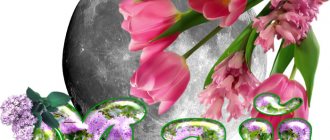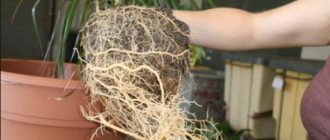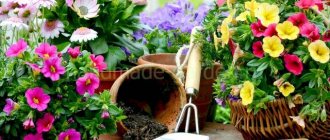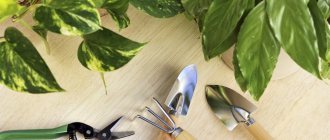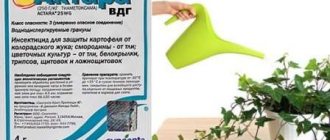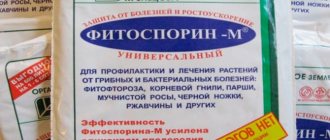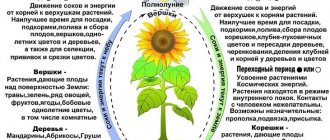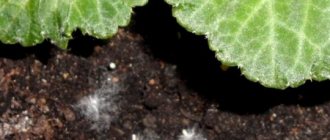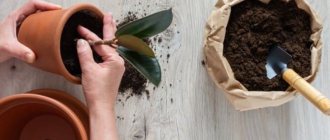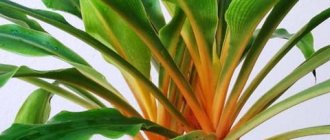Many people are familiar with the situation when a dry crust or white coating appears on the surface of the potting soil due to too much fertilizer.
I loosened the soil in the pot more and more. One time I even stuck a stick in one of the pots on the windowsill so I wouldn't have to look for it when I needed to loosen it. But after my friend Olga, an experienced gardener, told me about different methods of mulching the soil, I started using these methods.
How to transplant a flower into a pot without holes?
Planting rules: pots without
drainage holes Every drop of water you add to your
planter
will stay there.
While it is usually recommended to completely saturate the plant with water when watering, in a pot without
drainage you need to water a little and slowly so that the water flows evenly through the soil and does not accumulate at the bottom.
Interesting materials:
How to share photos on iPhone? How to share Geolocation iPhone locator? How to share a game on iPhone? How to share a book from iPhone? How to share contacts on iPhone? How to share contacts from one iPhone to another? How to share music from iPhone? How to share Wi-Fi password on iPhone? How to share WiFi password from iPhone? How to share an iPhone playlist?
Earth in flower pots
For the beauty and harmony of indoor plants, three components are needed: the plant itself, the pot and the surface of the soil. If the first two points are not in doubt (the plant must be healthy and well-groomed, and the pot must match the size of the plant’s root system), then not everyone is concerned about the aesthetics of the soil.
And in vain.
The soil can and should be hidden. This procedure is called mulching. Mulching effectively fulfills its purpose: it covers the ground and improves the growth conditions of plants.
When mulching, less moisture evaporates from the soil and prevents weeds and pests from entering the soil, which is also a definite advantage.
Today the editors of Yes, Straight! will tell you about some mulching methods that will make caring for your green pets easier and also decorate your home. Save it, it will come in handy later![1]
The material with which we cover the soil must be permeable to water and air and must not contain harmful substances.
Please note that not every covering material used for indoor plants can be used for them in the garden.
In the garden, we try to use types of mulch that will decompose over time and become part of the soil. In indoor gardening, the most important thing is the durability of the material and its beautiful appearance.
Types of mulch for flowerpots
- The most economical option is for those who have plants with beautiful colored leaves. These can be cut up and planted in potting soil. Particularly look for chopped herbs such as nettles, legumes and yarrow. These grasses are rich in macronutrients and nitrogen and can be used as soil amendments.
- Wild moss looks beautiful in a pot. Not only when they are green, but also when they are already yellow. If you don't have forest moss, you can use the kind sold in orchid kits.
- Pine mulch, made from bark, humus and sawdust, is an organic material that enriches the soil and regulates its acidity. Bark for mulching, humus, compost, peat, tea, pine needles and other substances can protect the plant from lack of moisture and also provide an additional source of nutrition.
- The pebbles look great. You don't have to use colored pebbles from the store - you can collect any small pebbles and wash them with hot water.
- Grass clippings are rich in nitrogen, but should be used with caution as they decompose quickly and can seriously impede the penetration of air into the soil.
- Straw is rarely used for pets, although it can reduce nitrogen levels and retain heat if needed.
- Synthetic materials are colored polystyrene sawdust that do not have any effect on the soil and plants. They do not interact with the soil, but perform a purely decorative function, retaining moisture in the soil and preventing it from evaporating.
Editorial Board
Plants, like people, need sunlight and warmth in winter. During the cold season, indoor plants often do not do well indoors. This occurs due to too dry air and lack of sunlight.
Here's how to help houseplants thrive in these harsh conditions.
Before mulching, make sure the soil in the pot is free of pests, mold and salt crust. The soil should be loose, without lumps or foreign impurities that can cause rotting.
Before starting work, the top layer must be smooth.
I am sure that these simple but very effective ways to care for pots can be useful to you. And don't forget to share this useful information with your friends on social networks!
How to loosen the soil in flower pots
Scientists and researchers from all over the world have repeatedly discovered that plants grow and bloom more readily when they hear pleasant music. This fact probably served as the main impetus for the creation of a musical pot for indoor plants.
We trust our clients and do not require advance payment. We respect your time, which is why we ship all orders by 1st class parcel only. The anti-smog umbrella can be picked up and paid for at the post office at a time convenient for you. Delivery cost 290 rubles.
A very unusual musical, with a multi-colored illuminated pot. Charged by USB, you can listen to music when you plant a flower, and then the leaves will play different notes when touched. Great gift.
Shipping costs are negotiable. Smart Music pots will give you a completely new experience of communicating with plants. A unique highly sensitive sensor inside the Smart Flower Pot allows you to use the flower as a musical instrument.
If you touch the leaves and flowers of a plant with your fingers, notes will sound. Just like a real piano!
Every time you touch the petals, it's like playing the piano. Thanks to a special sensor, a living plant in a smart pot turns into a musical instrument - every time you touch any leaf, it plays a note.
The houseplant salesman said I needed to loosen the soil to get air into the plant, but didn't tell me how to do it. To loosen the dirt in the pot, water the plant and then gently loosen it as it absorbs the water.
I've never seen sticks. I don’t loosen the soil, it’s already loose. Sometimes rods in houseplants have this effect on cats. Is it necessary to loosen the soil in flower pots? Is it necessary to loosen the soil in flower pots? Loosening the soil is best done the next day after watering, as the soil should dry out a little. I don't loosen the soil in pots - I usually try to mulch the soil, even in pots.
I mulch the soil in the pots with shells and pebbles from the sea. It is very beautiful, especially under indoor trees (palm, ficus, toadgrass). Loosening the soil in flower pots. Loosening in the greenhouse is carried out every 1.5-2 weeks, starting a week after planting the seedlings, and the soil is lightly loosened, picking up the plants as necessary.
How to loosen soil with carrots
Carrots have very long shoots, and loosening them can damage the crop. Now you can find out what it means to see loosening the soil in a pot in a dream by reading below for free interpretations of dreams from the best online dream books of the House of the Sun!
Land as soil - financial situation: plowed - to good prospects, loose - to prosperity, wilted - to losses; rocky -.
I mostly have ficuses, I loosen them - if the soil in the pot is heavy and after watering it seems to me that the roots may rot (especially in cold weather). After loosening, the soil dries out much faster. I'm worried that my cat is constantly digging up the soil in the pot.
I didn't do anything but cut out a paper circle and cover the soil in the pot with it, I covered it with plastic wrap. Maybe it weakens him. The first thing to remember is that the mold in the pot will not go away if you remove a small clump of soil. To prevent mold from growing in your pot, constantly loosen the top layer of soil to ensure sufficient breathability.
Loosen the soil frequently; the top layer (1-2 cm) can be replaced with fresh soil. If the temperature is high and the room is not ventilated or lit, you will create ideal conditions for mold to grow in the soil in the pot. The soil in the pot should be loosened once or twice a week, being careful not to disturb the root system.
How to make sushi at home. Video recipe on how to make sushi and rolls at home.
Well-planned and effective tillage is the key to a good harvest. It is impossible to disagree with this statement, which is why in spring and autumn gardeners devote a lot of time to their plots to prepare them for the new season or winter.
Answers to pressing questions
Question No. 1.
What is more correct - to loosen or mulch the plantings?
Both methods are equally applicable for complete plant care, and have their pros and cons.
Question No. 2.
Is it possible to combat soil crust before germination by methods other than loosening and mulching?
If there is water on the site, you can water the beds by sprinkling with a fine spray before emergence, preventing the crust from drying out. And after germination, carry out fine loosening.
Question No. 3.
How to loosen beds with carrots, they take a very long time to sprout, and when loosening the crops can be damaged?
For beds with slow-germinating seeds, there is a “blind” processing rule. When planting, faster-germinating ones such as radish, lettuce, and radish are mixed with such seeds. They represent rows. Loosening and weeding can be carried out focusing on these “beacons”.
Question No. 4.
Is it necessary to loosen the soil under the mulch?
This depends on the type of mulching material used and the condition of the soil. A crust does not form under the mulch, but if the soil is compacted, it should be loosened or pierced with a fork.
Timing and methods of loosening
Loosening is carried out in the following periods:
- before planting plants or sowing seeds;
- after planting plants or sowing seeds, usually after 1-1.5 weeks for the plants to take root;
- before and after watering, fertilizing or heavy rain, how the moisture is absorbed (usually the next day);
- loosening of row spacing is carried out as weeds and crusts appear on the soil.
The loosening technique is directly related to the types of soil, the characteristics of the planted plants, as well as the stages of their development. " The following methods are distinguished.
Deep loosening of the soil
It is carried out in preparation for planting plants with powerful and long roots, especially on heavy, infertile soil, often with the addition of sand and fertilizers. Loosening is carried out to a depth of 35 cm to 50 cm. In this case, the top layer of soil is removed, the lower layers are dug up and loosened, and then the removed soil is returned to its place and also thoroughly loosened.
Tip #1. When deep loosening in spring, pay attention so that the upper frozen layers do not fall down; at depth they will not melt soon and will absorb the heat needed by young plants.
Deep loosening of the soil
Loosening the subsoil
It is used when preparing the soil for planting. In this case, the top layer of soil is thrown aside, the subsoil layer is loosened and sprinkled with the top layer located nearby, breaking up all the lumps and thus loosening the entire intended area.
Please note that there should not be a gap in time between pre-planting preparatory loosening of the soil and planting seeds or seedlings, because there will be a loss of moisture from the top layer.
Fine loosening of the surface crust
Used to improve gas exchange and destroy crust. In the spring, deeper loosening is carried out - 7-10 cm, and in the summer it is shallower (3-6) so that the earth does not dry out. Care should be taken to loosen the row spacing when growing plants from small seeds or with short roots, so as not to harm the plantings.
Heavy soils require frequent loosening, while light soils can be cultivated less frequently. It is believed that each timely loosening is similar to two full waterings, since it preserves soil moisture.
How to properly loosen the soil of indoor flowers?
Useful on the topic: “How to properly loosen the soil of indoor flowers?” with comments from our professionals. If you have any questions as you read, leave them in the comments to the article.
Previously, I loosened the soil in the flower pot more and more. I even stuck some kind of stick into one of the pots on the windowsill so that I wouldn’t have to look for it when I needed to loosen the soil. But after my friend Olga, an experienced gardener, told me about different methods of mulching the soil, I began to use these particular methods.
Features of loosening the soil when growing vegetables
Loosening is necessary for all types of plants. It is not always used only in those places that are covered with a layer of mulching material. The depth of loosening primarily depends on the depth of the roots and their placement.
Rules for loosening vegetable beds
- Carrots, beets, other root vegetables, corn and plants with a developed root system initially require shallow loosening (3-6 cm), and as they grow, the loosening is made deeper, up to 12-15 cm. For slow-germinating seeds (carrots, dill and etc.) they use planting beacon plants (lettuce, radishes), which quickly sprout and mark the rows. This is necessary in order to quickly begin loosening and not damage the plantings.
- In pumpkin plants, the root system is located on top, and additional roots are formed on the stems. At the very beginning, loosening can be carried out more deeply (7-9 cm), and then it is carried out very carefully, shallowly (3-5 cm), without lifting the stems. Many experts advise replacing loosening with mulching, because even minor damage to the roots can lead to stunted plant growth and disease.
- They do the same in the area with tomatoes. Near an adult bush, the soil is loosened carefully and shallowly so as not to touch the roots; it is better to sprinkle the ground with peat to prevent the formation of a crust. Loosening activities are carried out between the rows.
- In potatoes, after hilling, the row spacing is loosened, as a rule, after rainfall or watering; this is not done in dry weather.
Hilling up potatoes and loosening row spacing - Beds with onions are loosened between rows by 2-3 cm so as not to damage the bulbs and roots.
How to avoid mistakes when loosening?
Mistake #1.
Sometimes gardeners carry out pre-planting loosening of the soil, and the seeds are planted in the prepared beds after a few days; moisture loss occurs.
Plant seeds or seedlings immediately after pre-loosening the beds to preserve soil moisture.
Mistake #2.
Loosening after rain is carried out too early, when the ground has not yet dried out enough.
Wait for the soil to dry out sufficiently. If there is still wet soil on the tools, loosening is not carried out.
Seeing or receiving a beautiful piece of land in a dream is a harbinger of a happy family life.
Well-groomed land with beautiful gardens in a dream is a sign of great family happiness.
Land covered with greenery or moss in a dream means money or a profitable marriage.
A barren land is dreamed of by those who face failure and bitter losses.
If you dream that the land is sown with wheat, then your hard hard work will help you become rich.
Kissing or eating the ground in a dream means humiliation and loss.
Vegetables growing on the ground are a sign of grief and trouble.
To see fertile, black soil terrain means your opportunities that you are missing due to laziness or weakness of character. Sometimes such a dream warns of excessive gullibility. The larger the plot of land that you see in your dream, the more wealth, joy and happiness awaits you in life.
If you dream that you are desperately digging the ground, then you should moderate your selfish appetites so as not to repent of it later.
Plowing, sowing, fertilizing, planting seeds in the ground in a dream means profit and growth in prosperity. For those getting married, such a dream predicts a strong family and healthy children.
Wet soil that has turned to slurry predicts illness. If you get dirty with it, then expect shame and strife. See interpretation: slurry, dirt.
Measuring out a plot of land in a dream is a sign of discord with relatives. Measuring a plot of land in a dream foretells that your situation will be desperate and your loved ones will begin to feel sorry for you. Place markings on the ground - for divorce or division.
Seeing the dug up earth is sometimes a sign of a funeral. Especially if you see it under the window of your house or near the house of your loved ones.
A ruined land is dreamed of by those whose lives are not settled. Such a dream does not bode well for them soon.
If rods, sticks, or pieces of wire stick out from the ground, then expect delays in resolving your case. In addition, you have enemies who are trying in every possible way to harm you. And this dream also means that you have made a lot of mistakes in your life. Try to correct errors if possible.
Seeing the earth from a ship in a dream is a sign of imminent success that will follow long experiences and searches.
If you see a foreign country, they will soon make you an interesting offer related to the trip.
The earth opened up under your feet in a dream - a sign that a collapse awaits you in business and in love. Such a dream predicts long suffering, disappointment and humiliation. See interpretation: earthquake.
Getting stuck in muddy ground in a dream means that your business will stall. If in a dream you are lucky and you get out of the swamp, then fate will generously reward you for your hard work. See interpretation: swamp.
Seeing diggers in a dream means that your enemies are waiting for your death.
Lying on the ground in a dream is a sign of the unsettled nature of your life and the collapse of your plans for the future. After such a dream, it may well be that you will lose your livelihood.
If you dream that the earth has collapsed before your eyes, or see an earthly failure in a dream, then your plans will fail completely, troubles or misfortunes await you. They say that such a dream predicts good luck for those who owe money or are going on a journey, since it promises to the first that they will not have to pay debts, and to others that their journey will be successful.
Interpretation of dreams from the Family Dream Book
Subscribe to the Dream Interpretation channel!
Subscribe to the Dream Interpretation channel!
As a rule, the owner of a houseplant knows when to water it, in what quantity and how often. But many owners of nature’s beautiful creations do not know about the soil found in flower pots. The soil should be selected depending on the individual characteristics of indoor plants. If the plant and soil do not match, the plant may wither and the soil may become covered with a white shell.
Tools and techniques for loosening the soil
There are a variety of devices for tillage by loosening the soil: manual, mechanical, electric. Please ensure that they are comfortable, ergonomic, reliable, and made of durable material, such as special tool steel.
Tip #2. It is advisable to purchase manual rippers with bright colored handles so that they are clearly visible on the soil if they are accidentally forgotten.
The following tools are used for loosening:
- Hoe;
- Rake;
- Flat cutter;
- Manual rippers;
- Garden forks;
- Shovel-baking powder;
- Rotary hoes;
- Manual, electric and mechanical cultivators;
- Harrows of various configurations.
Tools for work are selected based on the required gripping depth and row spacing. The soil should dry out from moisture and dew, so the best time for work is the beginning of the day, when there is no extreme heat.
Tools are selected depending on the depth of loosening and the width of the rows; the soil must be dry from moisture
The soil is loosened well, removing the crust, and leveled. During deeper loosening, no large lumps or blocks of earth should remain on the surface; they should be carefully broken up and the soil should also be leveled. It is easier to loosen heavy soil with a flat cutter.
Tip #3. The soil should not stick to the tool when loosening; you should wait until the moisture is better absorbed.
Do I need to change the soil in pots?
There is no specific correct answer to this question, but still, more positive opinions are given towards periodically replacing the soil in pots.
Over time, the earth loses its mineral wealth and becomes unable to enrich the plant with useful substances. In addition, over time, a white coating appears on the ground. The cause of such plaque can even be an excess of fertilizers, for example, salt contained in the water with which a houseplant is watered.
Plaque can also form due to insufficient loosening of the soil cover, that is, the crust in the surface layer of the earth prevents water from evaporating.
As a rule, it is recommended to change the soil once a year, but this period is relative. You need to look at the external state of the earth. The more often watering is done, the shorter the interval between soil replacements. Also, the soil must change as the flower grows; when long roots grow, there is not enough soil to feed them, so you need to replant the flower in a large pot, respectively, with a large amount of soil.
For small plants it is not recommended to use large pots; they inhibit the growth and development of the plant.
Mulch for indoor flowers
Mulching will not hurt to preserve moisture. Under a layer of mulch, the soil also remains looser and retains moisture for a long time.
For many indoor plants (as well as garden ones) this is very important. Mulching the soil creates more favorable conditions for the growth and development of plants. After all, the air that penetrates the upper layers of the soil contains not only oxygen, but also carbon dioxide, which takes part in plant photosynthesis.
You can use forest moss as mulch for indoor plants (if not, you can use sphagnum moss, which is sold for orchids); pine sawdust, bark mulch; humus; small pebbles. From synthetic materials, you can use colored foam chips.
Video - Mulching the soil at home
Gardener's review of loosening
On my small plot I grow various vegetables, herbs, and have a little bit of everything. I have always believed that loosening is a very important element of care, just like watering. Without it, the earth quickly compacts, becomes like stone, and plants wither and develop poorly. Therefore, I immediately made it a rule not to neglect the beds and loosen them after rainfall and watering, so that a crust does not form.
There are also some tricks here - you must wait for the soil to dry out, but not dry out completely. Then start loosening it. With regular care, moisture is well retained and much less watering will be required. I like to work with a tool like a flat cutter, but this, of course, is everyone's personal choice.
Different vegetables require different treatment. For example, beds with tomatoes, cucumbers, cabbage can be loosened deeper at the very beginning of plant development, and then, as they grow, you will have to reduce the depth and move away from the stem so as not to damage the roots. On the contrary, we first loosen root vegetables by 3-5 cm, and then increase the depth as they grow. Such simple rules help keep the soil in a loose state, and plants grow better on it, and the harvest is pleasing!
Why do you need to loosen the soil in the garden or in flower pots?
Loosening brings great benefits, allowing you to improve the structure of the soil and increase the yield. Let's consider all the advantages of this method of care:
- Providing soil with air. All plants at any phase of their development require the presence of oxygen. But if the above-ground part receives constant access to it, then the roots, especially on dense soils, as well as in the presence of a formed crust, begin to experience oxygen starvation. Plants begin to get sick and wither. In addition to oxygen, the air also contains carbon dioxide, which is involved in photosynthesis.
The task of the gardener and gardener is to regularly ensure the flow of air into the soil. To do this, the soil must be kept loose. - Improving soil structure. With the help of constant loosening, the soil structure improves, hard lumps are broken up, large stones and weed roots are removed, and it is aerated.
- Fighting soil crust. The crust appears after rains or heavy watering, especially on heavy clay soils. This “shell” prevents the penetration of air and does not allow crops to break through to the surface. Young seedlings, due to compaction of the soil and disruption of gas exchange in it, often develop root rot. Due to the capillaries formed in the crust, moisture evaporates from the soil more quickly. And again loosening will come to the rescue.
- Weed control. Cultivated plants suffer greatly from weeds, especially in the spring, when their violent growth can drown out the crops. Loosening the soil when the weeds are in the “white thread” stage, that is, they have just hatched from seeds, helps to significantly reduce their number.
- Moisture retention. Loosening the soil helps conserve moisture. That is why experts recommend carrying out this technique after every rain. And loosening in early spring will preserve reserves of snow moisture, which will have a beneficial effect on crops and will help increase yields. After all, snow cover contains up to 30-50% of all annual precipitation.
- Destruction of pests. Many pests that overwinter in the ground will not be able to get up after spring loosening and will die.
